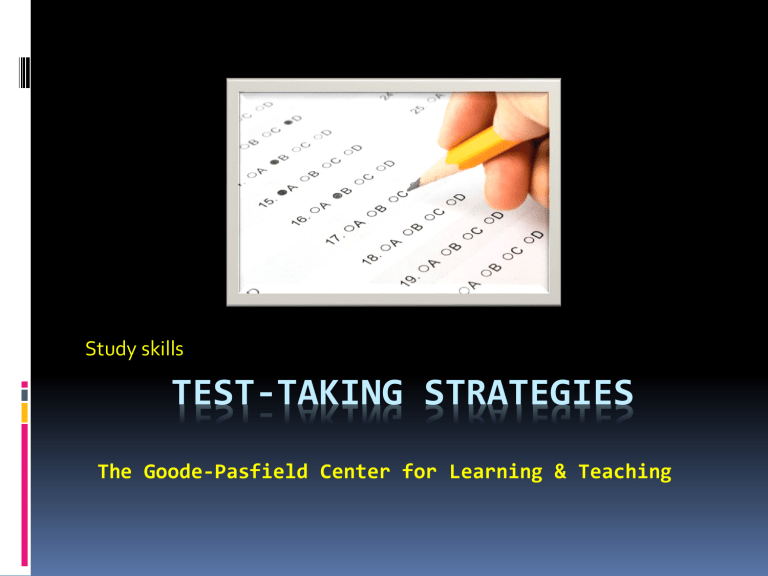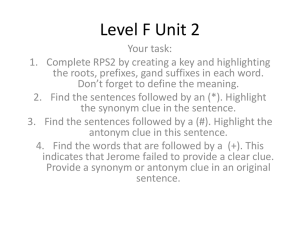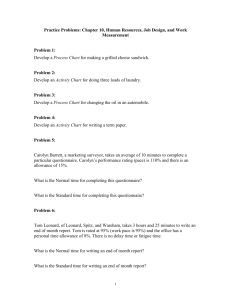Test-Taking Strategies

Study skills
TEST-TAKING STRATEGIES
The Goode-Pasfield Center for Learning & Teaching
Test-Taking Strategies
Five Day Test Preparation Plan
Multiple Choice Tests
True/False Tests
Matching Tests
Completion Tests
QUOTE Strategy for Taking Tests
2
Five Day Test Preparation Plan
Day 5
Read textbook & class notes
Look at any handouts from your class
Highlight the information in your notes & handouts that you will need to know
Day 4
Use mnemonic techniques and practice what you will need to know
3
Five Day Test Preparation Plan
Day 3
Rewrite the information in a brief form using the fewest words possible
Use the mnemonic strategies to review your rewritten notes at least twice per day
Day 2
Think of questions your teacher might ask you on the test
Write each question and answer
4
Five Day Test Preparation Plan
Day 1
The Day of the test!
Review rewritten notes from day 3
Review questions & answers from day 2
You can do these things while eating breakfast, riding to school, or eating lunch
Just before the test, go over any information you are having difficulty remembering
5
Multiple Choice Tests
Weeding out absolute words;
Recognizing “umbrella” (or “fusion” ) questions;
6
Multiple Choice Tests
“Umbrella” Questions: Also known as
“fusion” questions, seem to have four correct answers.
1.
a.
b.
c.
d.
Which of the following is a part of a car?
Oil filter
Engine
Carbeurator
Air filter
7
Multiple Choice Tests
The correct answer is “B”, engine.
You probably noticed that all of these choices look like “good” answers. This is a clue that you have an umbrella, or “fusion” question.
The clue is that three of the answers fit within the category of the fourth. In this case, carbeurator, air filter and oil filter are all parts of the engine, so “engine” is the correct answer. You may also notice that “engine” is a more general term than the others. Let’s try another…
8
Which of the following is a part of the human leg?
a.
The femur b.
The thigh c.
The quadriceps d.
The hamstrings
Right away, you probably recognized that these are ALL part of a leg, so how do you decide . This is an example of another
“umbrella” question.
9
The Answer Is…
“B”, the thigh, because the others are all part of the thigh, which again is also the most general of the terms.
10
…and another
Which of the following is found in the U.S.?
a.
Richmond b.
Roanoke c.
Lynchburg d.
Virginia
11
And the Answer IS…
You probably got that one right!
It’s “D”, Virginia, because the others are located in Virginia.
12
Absolute Words
Another obstacle to taking multiple choice tests is when absolute words appear in the choices. At the right is a list of some absolute words.
These usually make a sentence false.
None
Never
All
Always
Every day
Only
Must
13
1.
A.
B.
C.
D.
Here is an example:
The result of Barney’s study showed that:
All people suffer from SPAK
No people suffer from SPAK
SPAK never occurs in young people
SPAK may be found more in older people
14
The answer is “4”
Did you notice that choices 1, 2 and 3 contained the absolute words “all”, “no”, and
“never”. In general, absolute words limit too many options to be good choices for an answer.
The correct choice, however, was more general – it contained the word “may”.
15
Here is another example:
People with chronic disease can be described as: a.
Inevitably in pain b.
Always grouchy c.
Never able to walk d.
Needing more assistance
16
The Answer is…
Can we really say that these people are
ALWAYS grouchy or INEVITABLY in pain or
NEVER able to walk? Of course not. The correct answer is “D”, “needing more assistance.”
17
What about unfamiliar words?
Some MP questions are phrased using words you have never heard. They may even be made-up words. Most students “freak out” when they see those words, and decide to guess at the answer.
However, this is another test of your deductive reasoning. If you ignore the strange word, does the question still make sense? Can you answer it without knowing what the word means?….
18
Let’s take a look….
You are treating a patient with Kupe’s disease. When comparing cotylenol to bitylenol, which of the following would be the most appropriate intervention for this patient?
a.
Cotylenol is more appropriate b.
Bitylenol is more appropriate c.
Bitylenol is not as appropriate d.
Both a and b
19
This requires more deductive reasoning…Look at the clues in the scenario given.
1.
2.
3.
You don’t know what Kupe’s disease is;
You have never heard of “ cotylenol ” or
“ bitylenol ”;
All of the above are made up words, but it doesn’t matter.
20
Here are the choices again..
a.
Cotylenol is more appropriate b. Bitylenol is more appropriate c. Bitylenol is not as appropriate d. Both a and b
•
•
•
The answer can’t be “d” because you are asked to choose between either cotylenol or bitylenol.
The answer can’t be “a” or “c” because they say the same thing
That only leaves “b” as an answer, even though you have no idea what “Kupes” disease is. No need to freak out when you see unfamiliar terms!
21
The more complex question asks you to :
Prioritize the answers in some order (most important, best, last, first, initial, etc.);
Use deductive reasoning;
Also use your content knowledge;
Compare only the answers that are given
22
True/False Tests:
Choose TRUE unless you know the statement is
FALSE;
For a statement to be TRUE, everything about the statement must be TRUE;
Be careful when a statement has a negative such as “not”, “do not”, or “in” (e.g. “infrequent”) and
“un” (e.g., “unfriendly”)
A negative can completely change the meaning of the statement
23
True/False Tests:
If a statement has two negatives, cross out both negatives
This will make it easier for you to understand the statement
It is never not a good idea to serve the people.
Absolute statements are usually FALSE
Absolute statements include words such as
All, every, never, no (Dogs are never bald.)
Qualified statements are usually TRUE
Qualified statements include terms such as
Some, most, sometimes, rarely (Some dogs are bald.)
24
Answer these T/F questions:
It is never not a bad idea to sleep late.
People in the middle ages were always short.
Some of the Shawnee Indians were astrologers.
All of the students have a GPA over 2.5.
None of the scientists believe in God.
25
Matching Tests:
Read all the items in both columns before making any matches
Start by making the matches about which you are sure
Cross out items in both columns as you make matches
Make your best guess for remaining items, unless there is a penalty for guessing
26
Completion Tests:
Read the item and think about what is missing
Write an answer that logically completes the item
Be sure your answer fits the item grammatically
Use the length of the line as a clue to the length of the answer
Unless the length of the blank is the same for all answers
After you write the answer, read the entire answer to make sure it makes sense.
27
Examples:
There were too many people coming into the colony, and there was not enough
________,which led to many issues.
Supplies will last far into the _________due to advances in exploration and production.
There were no identified problems that would alter ____________recommendations
28
QUOTE strategy for Essay tests
Q – Question
Look for direction (discuss, describe, explain)
U – Underline
Words that help focus on ideas to develop answers
O – Organize/Write
The facts & write your answer
T – Time
Decide how much time to spend on answering each item
E – Evaluate
The content & organization of what you wrote & your mechanics
29
QUOTE strategy for Essay Tests:
Writing a One-Paragraph
Answer
Begin with an introductory sentence that contains your main point
Follow with sentences that support your point
End your answer with a sentence that states your conclusion
Writing a Multiple-
Paragraph Answer
Begin with an introductory paragraph that contains your main point
Follow with additional paragraphs, each with a supporting point
End with a paragraph in which you state your conclusion
30
31







